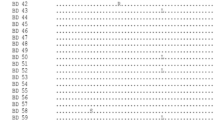Abstract
Backgrounds
Hepatitis B virus (HBV) is vulnerable to many various mutations. Those within epitopes recognized by sensitized T cells may influence the re-emergence of the virus. This study was designed to investigate the mutation in immune epitope regions of HBV pre-core/core among chronic HBV patients of Golestan province, Northeast Iran.
Methods
In 120 chronic HBV carriers, HBV DNA was extracted from blood plasma samples and PCR was done using specific primers. Direct sequencing and alignment of the pre-core/core region were applied using reference sequence from Gene Bank database (Accession Number AB033559).
Results
The study showed 27 inferred amino acid substitutions, 9 of which (33.3%) were in CD4 and 2 (7.4%) in cytotoxic T lymphocytes’ (CTL) epitopes and 16 other mutations (59.2%) were observed in other regions.
Conclusions
CTL escape mutations were not commonly observed in pre-core/core sequences of chronic HBV carriers in the locale of study. It can be concluded that most of the inferred amino acid substitutions occur in different immune epitopes other than CTL and CD4.

Similar content being viewed by others
References
Ganem D, Schneider RJ. Hepadnaviridae: the viruses and their replication. Fields Virol. 2001;2:2923–69.
Alexopoulou A. Mutants in the precore, core promoter, and core regions of hepatitis B virus, and their clinical relevance. Ann Gastroenterol. 2009;22:13–23.
Jung MC, Pape GR. Immunology of hepatitis B infection. Lancet Infect Dis. 2002;2:43–50.
Penna A, Del Prete G, Cavalli A, et al. Predominant T-helper 1 cytokine profile of hepatitis B virus nucleocapsid-specific T cells in acute self-limited hepatitis B. Hepatology. 1997;25:1022–7.
Sobao Y, Tomiyama H, Sugi K, et al. The role of hepatitis B virus-specific memory CD8 T cells in the control of viral replication. J Hepatol. 2002;36:105–15.
Webster GJ, Reignat S, Brown D, et al. Longitudinal analysis of CD8+ T cells specific for structural and nonstructural hepatitis B virus proteins in patients with chronic hepatitis B: implications for immunotherapy. J Virol. 2004;78:5707–19.
Chang JJ, Wightman F, Bartholomeusz A, et al. Reduced hepatitis B virus (HBV)-specific CD4+ T-cell responses in human immunodeficiency virus type 1-HBV-coinfected individuals receiving HBV-active antiretroviral therapy. J Virol. 2005;79:3038–51.
Urbani S, Boni C, Amadei B, et al. Acute phase HBV-specific T cell responses associated with HBV persistence after HBV/HCV coinfection. Hepatology. 2005;41:826–31.
Locarnini S, Eds. Virology of Hepatitis B Virus. Molecular. Seminars in liver Disease. Copyright© 2004 by Thieme Medical Publishers, Inc., 333 Seventh Avenue, New York, NY 10001, USA. 2004.
Kakimi K, Isogawa M, Chung J, Sette A, Chisari FV. Immunogenicity and tolerogenicity of hepatitis B virus structural and nonstructural proteins: implications for immunotherapy of persistent viral infections. J Virol. 2002;76:8609–20.
Hunt CM, McGill JM, Allen MI, Condreay LD. Clinical relevance of hepatitis B viral mutations. Hepatology. 2000;31:1037–44.
Gholamreza R, Shahryar S, Abbasali K, et al. Seroprevalence of hepatitis B virus and its co-infection with hepatitis D virus and hepatitis C virus in Iranian adult population. Indian J Med Sci. 2007;61:263–8.
Merat S, Rezvan H, Nouraie M, et al. The prevalence of hepatitis B surface antigen and anti-hepatitis B core antibody in Iran: a population-based study. Arch Iran Med. 2009;12:225–31.
Alavian SM, Fallahian F, Lankarani KB. The changing epidemiology of viral hepatitis B in Iran. J Gastrointestin Liver Dis. 2007;16:403–6.
Alghamdi A, Aref N, El-Hazmi M, et al. Correlation between hepatitis B surface antigen titers and HBV DNA levels. Saudi J Gastroenterol. 2013;19:252–7.
Mohamadkhani A, Jazii FR, Poustchi H, et al. The role of mutations in core protein of hepatitis B virus in liver fibrosis. Virol J. 2009;6:209.
Park YM, Kim BS, Tabor E. Precore codon 28 stop mutation in hepatitis B virus from patients with hepatocellular carcinoma. Korean J Intern Med. 1997;12:201–7.
Loggi E, Bihl FK, Cursaro C, et al. Virus-specific immune response in HBeAg-negative chronic hepatitis B: relationship with clinical profile and HBsAg serum levels. PLoS One. 2013;8:e65327.
Kim D, Lyoo KS, Smith D, et al. Number of mutations within CTL-defined epitopes of the hepatitis B virus (HBV) core region is associated with HBV disease progression. J Med Virol. 2011;83:2082–7.
Gu XB, Yang XJ, Wang D, Hua Z, Xu YQ, Lu ZH. Relationship between serum HBV DNA level and HBV-specific, nonspecific cytotoxic T lymphocytes and natural killer cells in patients with chronic hepatitis B. Chin Med J (Engl). 2009;122:2129–32.
Cheng CP, Lee PF, Liu WC, et al. Analysis of precore/core covariances associated with viral kinetics and genotypes in hepatitis B e antigen-positive chronic hepatitis B patients. PLoS One. 2012;7:e32553.
Alexopoulou A, Baltayiannis G, Eroglu C, et al. Core mutations in patients with acute episodes of chronic HBV infection are associated with the emergence of new immune recognition sites and the development of high IgM anti-HBc index values. J Med Virol. 2009;81:34–41.
Sun L, Zhang Y, Zhao B, et al. A new unconventional HLA-A2-restricted epitope from HBV core protein elicits antiviral cytotoxic T lymphocytes. Protein Cell. 2014;5:317–27.
Moradi A, Zhand S, Ghaemi A, Javid N, Tabarraei A. Mutations in the S gene region of hepatitis B virus genotype D in Golestan Province-Iran. Virus Genes. 2012;44:382–7.
Acknowledgements
This study was performed with financial support from the Research Deputy, Golestan University of Medical Sciences.
Author information
Authors and Affiliations
Corresponding author
Ethics declarations
Conflict of interest
SZ, AT, AN, and AM declare that they have no conflict of interest.
Ethics statement
The authors declare that the study was performed in accordance with the Helsinki declaration of 1975, as revised in 2000 and 2008 concerning human and animal rights, and the authors followed the policy concerning informed consent as shown on springer.com.
Rights and permissions
About this article
Cite this article
Zhand, S., Tabarraei, A., Nazari, A. et al. Cytotoxic T lymphocytes and CD4 epitope mutations in the pre-core/core region of hepatitis B virus in chronic hepatitis B carriers in Northeast Iran. Indian J Gastroenterol 36, 253–257 (2017). https://doi.org/10.1007/s12664-017-0767-z
Received:
Accepted:
Published:
Issue Date:
DOI: https://doi.org/10.1007/s12664-017-0767-z




